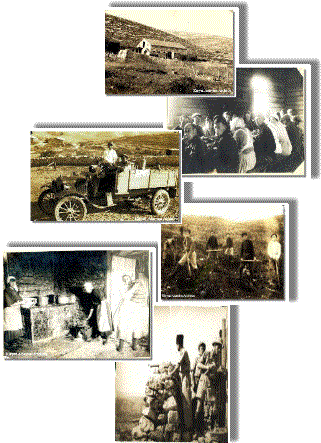History in short
Kiryat Anavim was the first Kibbutz settled in the Judean Hills, in Israel.
Located 12 km from Jerusalem,50 km from Tel Aviv 650 m above sea level.
The land was bought in 1913-14 from the Effendi of Abu Gosh by the Zionist
Organisation (Histadrut Hatzionit).
Beginning was hard, the first settlers left. Only in 1919 a new group of six
(one woman) arrived fom Russia they were part of a cooperative from Ukraine
who called themself "Co-Operative Eretz Israel". They arrived with the 3rd
Alliya and settled near by the small spring called "Dilb". This was the group
first name. The others joined them later. In 1920 the "Keren Kayemet" helped
the settlers by buildung terraces, planting saplings and financially too. By the
end of 1920 there were around 200 pioneers in Kiryat Anavim, coming leaving
all this time.
The main problem was the water, the small spring that was able to supply
water only till August each year, was enough for drinking only, they had to buy
water from the Monastry nearby. The first water pipes were laid in 1937 and
for agricultural purposes only about 1947. The early days they tried to grow
grapes then they planted apples peaches, plums, cherries.
They started a poultry farm mainly for eggs. Kiryat Anavim was the first dairy farm
to bring Dutch cows to the country. Farming in the rocky mountains was very difficult,
so the Kibbutz was given an area 40 km away to farm.
Industry in the beginning was a small metal workshop, making garbage containers
later fruit selector machines and in the last few years a large Insulation material
Factory In 1937 was the first attempt to host outside guests in small kibbutz rooms,
it was the first of the now famous Kibbutz Guesthouses.
During the Independence War Kiryat anavim was a very important Hagana defence
point as well as the main storage depot and outlet for food for Jerusalem which was
under siege.In the Military Cemetery you will find all the names of those brave heroes
who came to Israel to fight and fell in actions - burried in Kiryat Anavim Cemetery.

If your Hebrew is good enough you can read all about HERE
